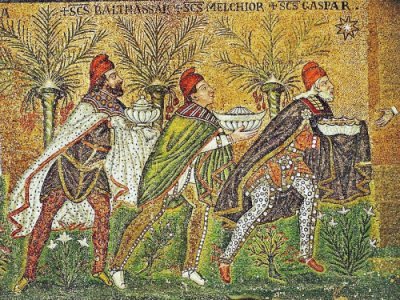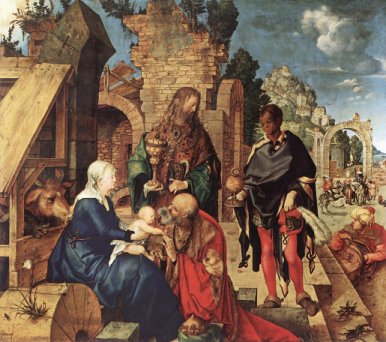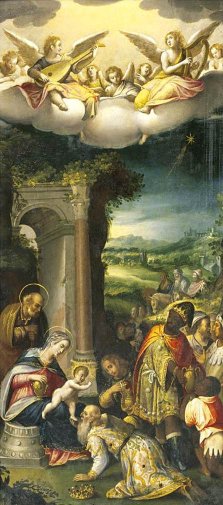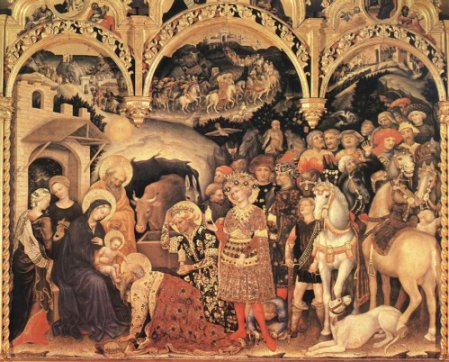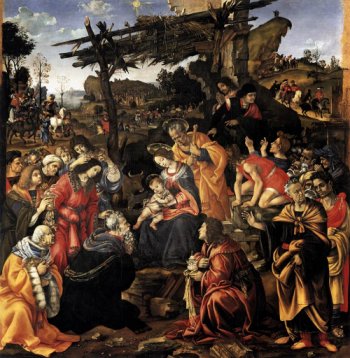|
|
|||
|
|
|||
|
Who were they? |
|||
|
|
|||
|
The names may have originated around 500 in a Greek Ms, translated into Latin as Excerpta Latina Barbari: At that time in the reign of Augustus, on 1st January the Magi brought him gifts and worshipped him. The names of the Magi were Bithisarea, Melichior and Gathaspa. Spot the Magus This may take some time! When I started this project I thought that identifying which magus was which would be an easy job. Sadly I'm more confused now that when I started. There are three variables: their age, their name and their gift. If you want, you can add a fourth - ethnicity - but three is plenty to be going on with. The problem is - no-one agrees. Here's James Hall in his much respected Dictionary of subjects and symbols in Art: The adoration itself shows Caspar, or Jasper, the oldest, kneeling before the infant Christ in the virgin’s lap, offering his gift of gold. Behind him stands Balthasar, a negro, and Melchior, the youngest. Compare this with Anna Jameson in Legends of the Madonna: In the legends of the fourteenth century, the kings had become distinct personages, under the names of Caspar (Or Jasper) Melchior, and Balthasar: the first being always a very aged man, with a long white beard; the second, a middle-aged man; the third is young, and frequently he is a Moor or negro, to express the King of Ethiopia or Nubia, and also to indicate that when the Gentiles were called to salvation, all the continents and races of the Earth, of whatever complexion, were included. In the old legend of the three Kings, as inserted in Wright’s ‘Chester Mysteries,’ Jasper, or Caspar, is King of Tarsus, the land of Merchants; he makes the offering of gold. Melchior, the king of Arabia and Nubia, offers frankincense; and Balthasar, King of Saba, ‘the land of spices and all manner of precious gums’ offers myrrh. Now this one: Balthasar, the youngest magus, bears frankincense and represents Africa. To the left stands Caspar, middle-aged, bearing gold and representing Asia. On his knees is Melchior, oldest, bearing myrrh and representing Europe. (Art site description of Adoration of the Magi by Vicente Gil Or this one: Long tradition has made them three; one Semitic, one European, one African; one young, one middle-aged, one old; by name Caspar, Melchior and Balthasar. Caspar is old and semitic, Melchior is middle-aged and European, Balthasar is young and African. (source unknown, but it is repeated verbatim over 50 times on the internet so it must be true!) In a text describing the Journey of the Magi in the Medici chapel, with images based on important visitors to Florence: The Magi themselves were carefully chosen. The oldest, Melchior, is assumed to represent Joseph, Patriarch of Constantinople, leader of the Orthodox Church and a key speaker at the Council of Florence. Balthazar, the middle-aged Magi, represents John VIII Paleologus, Emperor of Byzantium, and Cosimo's guest of honour. The youngest, Caspar, is believed to be Cosimo's grandson, Lorenzo de'Medici. Or finally this one from an assemblage of writing from the eighth century known as the Collectanea of pseudo-Bede, The first Magus was Melchior, an old man with long white hair and a long beard. It was he who presented gold, symbol of divine royalty. The second, named Caspar, was young, beardless, and ruddy; he honoured Jesus by giving incense, an offering that manifested his divinity. The third, named Balthasar, of dark complexion (fuscus), wearing a full beard…bore witness by offering myrrh, that the Son of Man would die. (I am grateful to Frank de Stefano for drawing my attention to this one, quoted in Emile Male, Religious Art in France, The Thirteenth Century) So that's that one sorted then. All one can say is that artists rarely labelled their pictures as the Ravenna mosaic does, and that traditions change over time and in different locations. There was an attempt in later depictions to identify the Magi with different countries, which is when the African magi began to appear. All one can say is that in most versions the oldest Magus had a white beard and brought the gold. Of course, all of this, and the designation of the Magi as kings (which was, it seems, dreamed up by Tertullian,) has no biblical authority at all, however often it is repeated in Christmas carols. Subjects in art By far the most common theme is the Adoration of the Magi. As we've seen when looking at later Nativity images, these became increasing complex and it is not always easy to pick out the Magi from their extended entourage. |
|||
|
|
|
||
|
|
|
|
|
|
|
|
||
|
Two from the Uffizi - join the queue! |
|||
